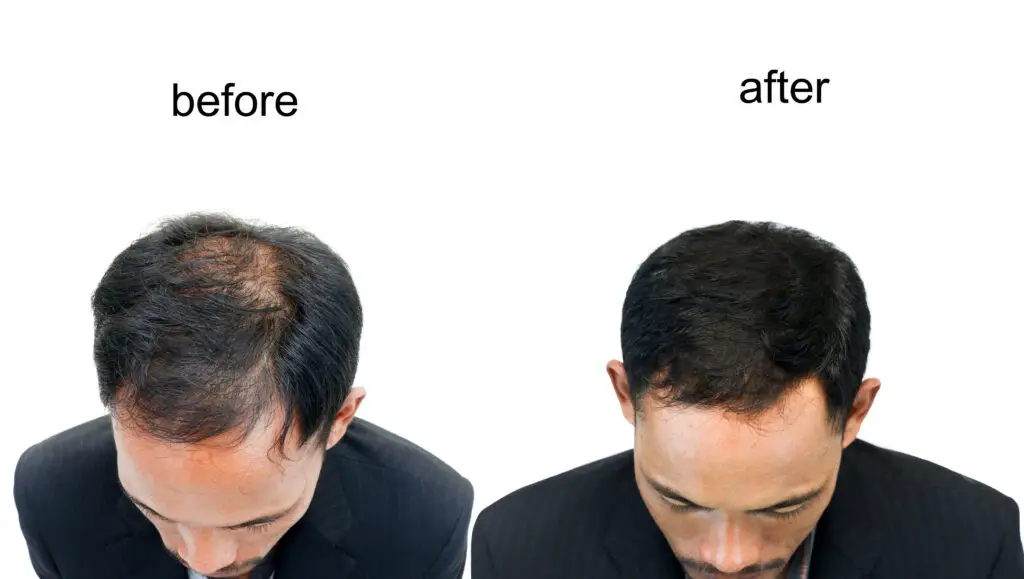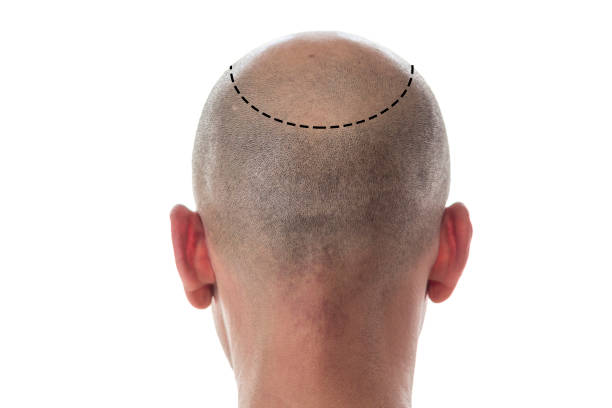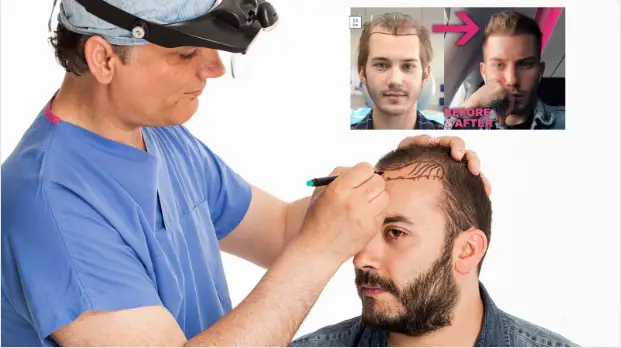If you’re considering a hair transplant, you may have come across the term “DHI hair transplantation.” But what is DHI, and what are its benefits? In this blog post, we’ll unravel the mystery of DHI hair transplantation and explain why it may be the best option for you.
Hair loss is an issue that affects millions around the globe, male and female alike. Once being regarded as an unstoppable symptom of aging, hair loss is now combatable thanks to technological and medical advancements. Various hair transplantation methods have emerged over recent decades, one of which is DHI (Direct Hair Implantation). This method possesses unique features and distinctions that set it apart from others, sparking vast interest among those counting on a reliable and effective solution to baldness. To get an accurate perspective, we’ll delve into the process of DHI, compare it to other types, assess the financial implications and time commitment, inspect the success rate and potential side effects, and garnish it with real-life experiences and results of patients who have chosen this form of hair transplantation.
So, What is DHI Hair Transplantation?
Direct Hair Implantation (DHI) is a modern hair transplant technique featuring a simplified and minimally invasive approach. It is one of the advanced methods practiced by aesthetic medicine specialists to address hair loss and baldness, improving both hair density and coverage.
The DHI Process
In DHI hair transplantation, each hair follicle is individually removed from a donor site, usually at the back of the head where hair growth is more substantial, with a specially designed disposable tool with a diameter of 1mm or less. This process is also known as harvesting.
Once the hair follicles are gathered, they’re implanted directly into the treatment area using a patented tool known as a ‘Choi Implanter.’ This device controls the angle, depth, and direction of the transplanted hair, ensuring natural-looking results. Unlike other transplantation methods, DHI does not require prior creation of channels or slits in the recipient area, which results in a more comfortable experience for the patient and less trauma to the scalp.
Who is Suitable for DHI?
DHI is suitable for both men and women experiencing hair thinning, receding hairline, bald patches or extensive hair loss. It is also effective in treating alopecia areata and androgenetic alopecia.
There are certain factors to consider before determining the right candidate for DHI. An ideal candidate has sufficient hair in the donor area, with a realistic expectation about the results that can be achieved. However, individuals with uncontrolled medical conditions such as heart and blood disorders, acute infections, uncontrolled diabetes, or wild scalp disorders may not be suitable for the procedure.
Patients considering DHI should consult with a qualified medical professional or a hair restoration expert to assess their individual suitability for the treatment based on their specific hair loss condition, scalp health, and overall medical history.
DHI Hair Transplantation: Expectations and Aftercare
Direct Hair Implantation or DHI is designed to improve one’s appearance by fostering hair regrowth. The extent to which this goal is achieved is based on individual factors such as hair type, strength, and density. Noticeable enhancements generally begin to surface around the three to four month mark while substantial hair growth might require six to nine months post-procedure.
Ensuring the success of a DHI procedure hinges significantly on post-procedure care. It’s recommended that patients abstain from washing their scalp for a couple of days post-surgery and should subsequently clean the area gently as the healing process commences. It is also advised to avoid strenuous physical activities, harmful exposure to sunlight and wearing tight hats that could damage the new hair grafts.
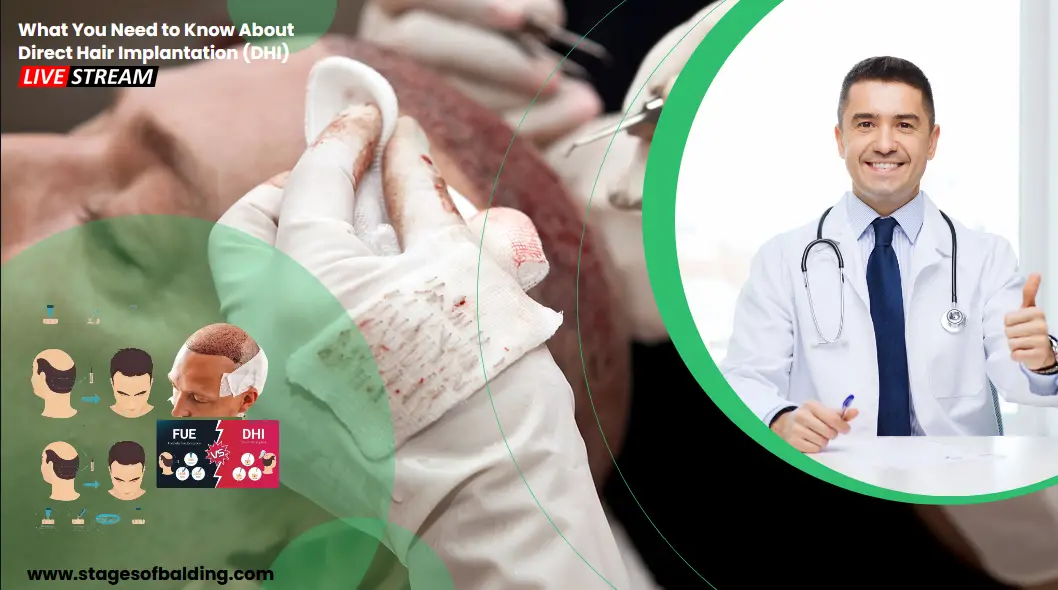
Comparing DHI Hair Transplantation to Other Types
Further Insight into DHI Hair Transplantation
Regarded as one of the most cutting-edge techniques in the hair transplantation field, Direct Hair Implantation (DHI) method revolves around the actual extraction and insertion of hair follicles. These follicles are typically harvested from a donor area – usually, the back of the scalp – and then grafted into a recipient area that is experiencing hair thinning or baldness.
Comparison with Other Hair Transplantation Methods
DHI is often compared to Follicular Unit Extraction (FUE) and Follicular Unit Transplantation (FUT), two of the other common hair transplantation methods. FUT involves removing a strip of scalp from the donor area, dissecting it into individual hair grafts, and implanting them into the recipient area, leaving a linear scar in the donor area. On the other hand, FUE involves extracting individual hair grafts from the donor area and transplanting them to the recipient area, leaving behind small, round scars.
You will also like: Norwood 5 Hair Transplant | Cost + 2,200 Grafts Needed!
Advantages of DHI Over FUE and FUT
DHI boasts multiple advantages over FUE and FUT techniques. The most significant advantage is that DHI doesn’t require the creation of pre-made holes on the recipient site for the implantation of hair follicles. This results in less bleeding, reduced risk of graft dislodgement, and faster healing time.
DHI also allows for the transplantation of a larger number of grafts in a single session and with greater density. Furthermore, it leads to a more natural-looking result due to the precision with which the direction, angle, and depth of the implanted hair follicles can be controlled.
Disadvantages in Comparison to FUE and FUT
Despite the many advantages, DHI has a couple of drawbacks when compared to FUE and FUT. First, DHI is usually more expensive than the other two methods due to the specialized tools and more meticulous technique involved. Second, the DHI procedure takes more time because each follicle is implanted immediately after being extracted, as opposed to FUE and FUT where all the grafts are extracted first and then implanted.
Understanding DHI Hair Transplantation
For individuals seeking hair restoration solutions, Direct Hair Implantation (DHI) may offer the ideal blend of natural-looking outcomes, speedy recovery, and no noticeable scars. This, however, comes at a higher cost and longer procedure time – factors that might have some patients considering alternative solutions like FUE or FUT.
Ultimately, the decision to choose DHI, FUE, or FUT is a personal one, shaped by factors like budgetary restrictions, time availability, degree of hair loss, and personal preference. It’s important for patients to get professional medical advice to decide the best hair transplant method for their specific circumstances.
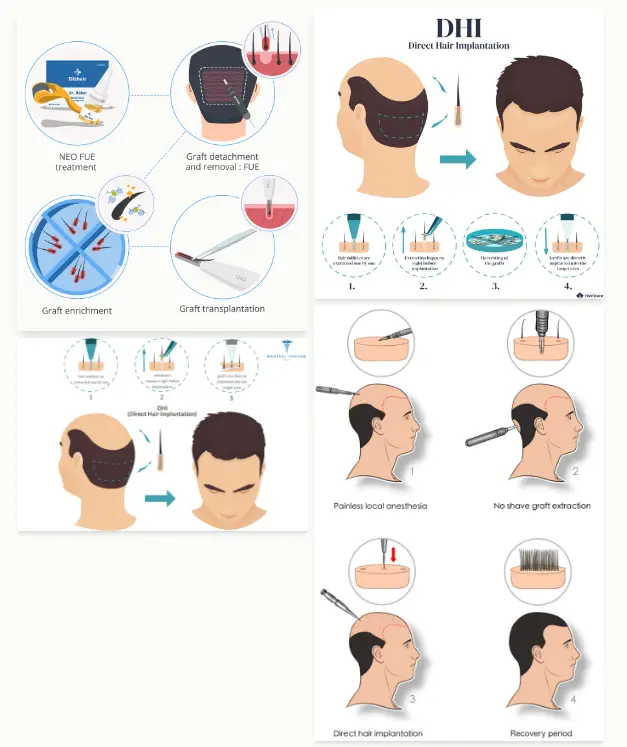
Cost and Time Implications of DHI Hair Transplantation
Factors Influencing DHI Hair Transplantation Cost
The cost of undergoing DHI can vary widely depending on a range of factors. A key determinant is the clinic itself; costs can drastically differ based on the clinic’s reputation, the skill set and depth of experience of the medical team, and the innovative techniques and technology used.
The number of grafts required for the treatment also significantly affects the price. The extent of hair loss directly impacts this number – more extensive hair loss requires a higher number of grafts, leading to a steeper overall cost.
The procedure’s location can also be a cost influencer. DHI tends to be more expensive in countries with high operational and living costs, prompting some individuals to seek treatment in foreign countries where the procedure can be more affordable due to lower living expenses.
Time Implications of DHI Hair Transplantation
In terms of time, a DHI hair transplantation procedure can be a significant commitment. The length of the procedure depends on the number of grafts required. It typically lasts anywhere from 4-8 hours but can extend to 12 hours in cases where a larger number of grafts are needed.
Patients should be prepared to dedicate a full day for the procedure itself, as well as additional time for consultation, preparation, and aftercare. Patients are usually able to return to their normal activities within a week, but this can vary based on the individual’s healing rate and the extent of the procedure.
Understanding the Recovery Period Following DHI Hair Transplantation
In comparison to other hair transplantation procedures, the recovery time after Direct Hair Implantation (DHI) is notably shorter. The majority of patients are usually able to resume their regular activities within 2-3 days post-procedure. Even so, it is crucial to take certain precautions – such as refraining from engaging in strenuous activities for a few days following the procedure.
Post-procedure, patients might experience swelling in the treated area, which typically subsides within a week. Other common side effects include mild pain, discomfort, and redness; all of which can be managed effectively by medication. Patients typically begin noticing significant hair growth after about 3-4 months, while the definitive effects of the procedure might take a year or longer to fully materialize.
Given these considerations, it is crucial to be mindful not only of the financial implications, but also the time commitment related to DHI hair transplantation. Potential patients are advised to consult with a number of clinics to gain a comprehensive understanding of the costs involved and to adequately prepare for the time required both for the procedure itself and for the subsequent recovery period.
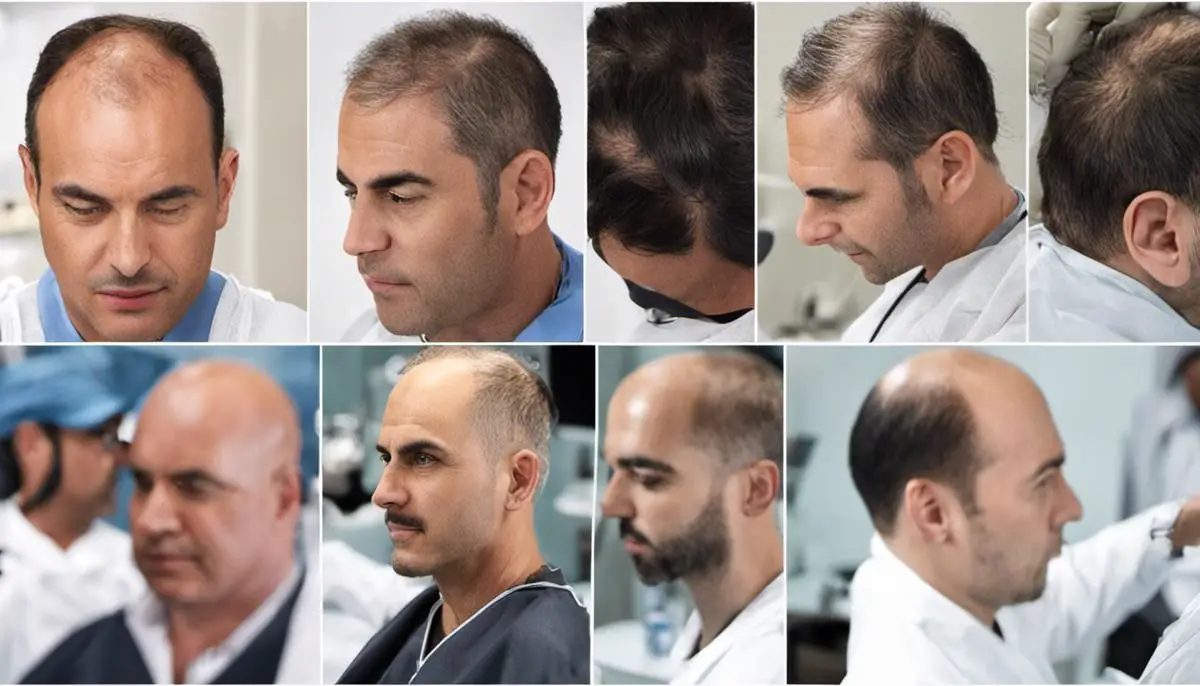
Success Rate and Potential Side Effects of DHI Hair Transplantation
An Insight into the Success Rate of DHI Hair Transplantation
Direct Hair Implantation (DHI) has gained recognition as amongst the most sophisticated and efficient methods in the realm of hair restoration. This method employs a patented tool named the Choi Implanter Pen to transplant hair follicles from a donor region (typically the back or sides of the head) straight to the recipient area. Owing to its precision and minimal invasiveness, this treatment approach has yielded impressive success rates.
Data shows that approximately 90% of hair follicles transplanted using the DHI hair restoration technique survive. The growth rate of this transplanted hair is quite remarkable, often reaching up to 90%. This survival rate substantially exceeds that of other hair transplant procedures which usually hovers around 70-85%. The high success rate places DHI hair transplantation a step ahead of its counterparts.
Factors Affecting the Success Rate
The success rate of a DHI hair transplant can depend on several factors. First, the skill and experience of the surgeon play a crucial role. A surgeon with extensive experience in performing DHI transplants is likely to achieve better results. Second, the patient’s overall health and lifestyle can influence the success of the transplant. Eating a balanced diet, quitting smoking, and avoiding stress can enhance the survival rate of the transplanned hair. In addition, observing post-operative care instructions, such as keeping the scalp clean and avoiding strenuous exercises, also helps to ensure better outcomes.
Possible Complications and Side Effects of DHI Hair Transplantation
Like every surgical procedure, DHI hair transplantation may come with some risks, which include:
- Swelling and Pain: Patients could experience temporary swelling and discomfort in the donor and recipient areas post-surgery, and this usually subside within a few days.
- Minimal Scarring: While DHI is a less invasive method compared to traditional hair transplant techniques and does not require scalpel cuts, minor scarring can still occur.
- Infection: Though rare, a minor risk of infection exists after the treatment. This can be prevented with appropriate aftercare and hygiene standards.
- Temporary Hair Loss: Often referred to as shock loss, this common side effect implies that transplanted hair may shed at first prior to new hair growth.
- Unsatisfactory Results: There’s always a possibility that the results might not meet the patient’s expectations, particularly if their expectations were unrealistic to begin with.
Understanding these potential complications and having a thorough discussion with the surgeon is crucial before deciding on the procedure. While DHI hair transplantation generally shows high success rates, the results vary for each individual, and an individual’s satisfaction largely relies on their personal expectations.
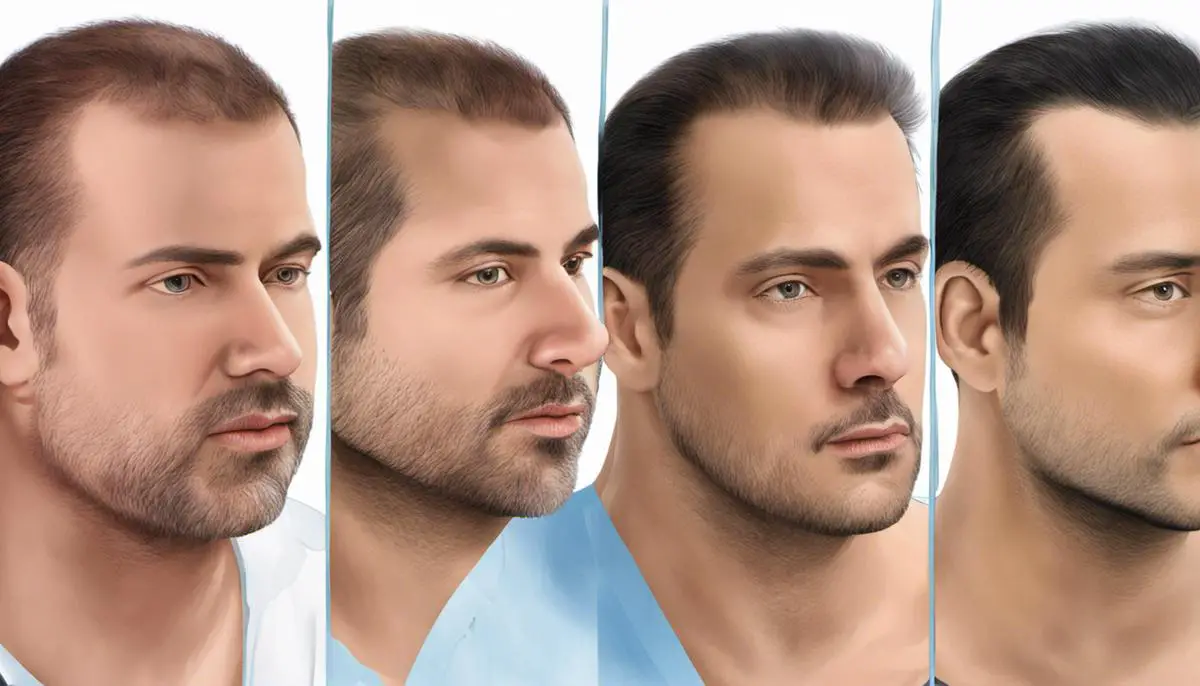
Real Life Experiences and Results of DHI Hair Transplantation
Getting to Know DHI Hair Transplantation
Direct Hair Implantation, or DHI, is a type of hair transplant procedure designed to be minimally invasive yet provide maximum hair density and a natural-looking hairline. This technique utilizes a proprietary tool known as the DHI implanter. The unique attributes of this tool provide surgeons with the ability to control the angle, direction, and depth of each implanted hair follicle, ensuring an excellent match with the existing pattern of hair growth.
Real Life Experiences and Results: Case Studies
Many individuals who have undergone DHI hair transplantation report a positive experience and are generally satisfied with the results. In a typical case study, a male in his 40s, with noticeable hair thinning, opted for DHI. The procedure was performed over two sessions, and within the span of a year, he saw significant improvements. Before the treatment, his hair was thinning dramatically at the crown and the temples. Post-treatment, he noticed a considerable amount of hair regrowth in the treated areas, creating a fuller and more youthful look. The results demonstrated a natural hairline and the patient reported increased confidence as a result of the treatment.
Patient Testimonials and Success Stories
Among many success stories, a standout comes from a woman in her late thirties who had experienced severe hair thinning due to hormonal imbalances. She decided to choose DHI transplantation after trying several over-the-counter solutions with little success. The procedure was completed in one session, and after nine months, she noticed remarkable improvement. Her hair became denser and she reported feeling more confident and happier after seeing the results.
Another positive testimonial comes from a young man who had started experiencing hair loss in his early 20s. After undergoing DHI transplantation, he observed noticeable growth within six months. Today, he enjoys a full head of hair and appreciates the advanced technology that helped him regain his youthful appearance.
Before and After Pictures
Pictures from before and after DHI transplantation greatly illustrate the impressive transformations, with patients usually noticing significant improvements in hairline and overall hair density. The process results in a healthier, more natural-looking hairline with no linear scarring, as the precision of the technique ensures a seamless match with the natural hair growth.
It’s essential to remember that individual results can vary, and it may take up to a year to see the full effects of the procedure. This timeframe is due to the natural growth cycle of the hair follicles.
Check out our best alternative to hair transplants.
Conclusion
DHI hair transplantation offers a significant advancement in the pursuit of hair restoration. The technique focuses on providing a natural look by respecting the specific growth pattern of each individual’s hair. As shown in many real-life experiences, patient satisfaction is high, with many individuals reporting regained confidence and a positive change in their life after the procedure. The before and after pictures demonstrate the effectiveness of this innovative method.
After a comprehensive exploration of DHI hair transplantation, it’s clear that the technique offers a promising solution for those grappling with hair loss. While the upfront costs may be steep and the process might require some time commitment, the high success rates and minimally invasive nature of the procedure generally outweigh the investment. Yet, it’s crucial to remember that every medical procedure comes with inherent risks and potential side effects. DHI, like any other treatment, isn’t exempt from this. Therefore, it’s essential to seek professional medical advice prior to making any decisions. Through showcasing personal stories and testimonials, we’ve seen how this procedure can make a profound difference in people’s lives, restoring not only their hair but also their confidence.
Reference:
- https://www.ncbi.nlm.nih.gov/pmc/articles/PMC3764758/
- https://www.ncbi.nlm.nih.gov/pmc/articles/PMC3764754/
- AI Powered Bald Filter Online 2024: See Yourself with No Hair! - January 19, 2024
- Harklinikken Bad Reviews 2024: Analyzing Negative Feedbacks - January 18, 2024
- How to Get the Alex Eubank Hair | Step-By-Step Tutorial 2024 - January 18, 2024



